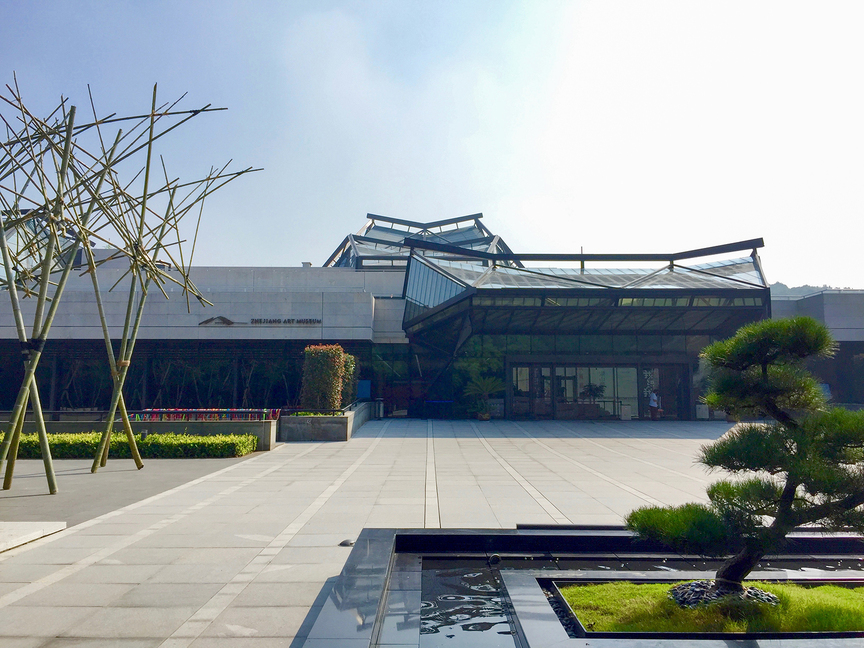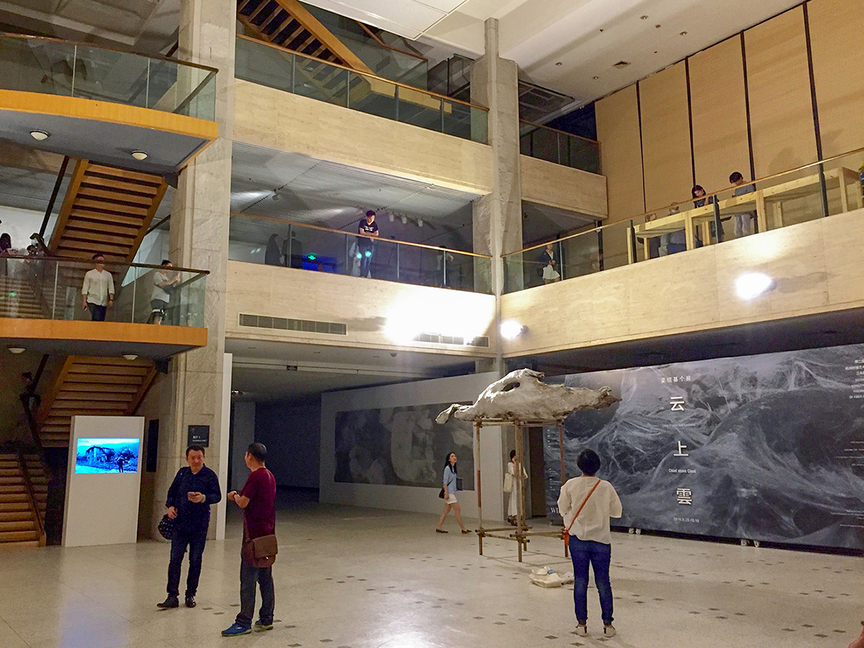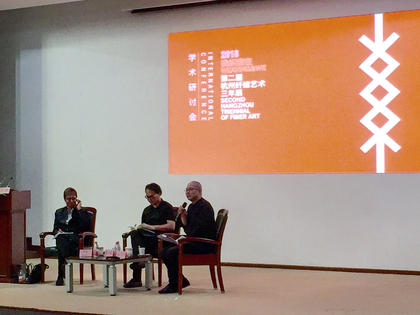
R
E
V N
E
X
T
The genre of fiber art tends to be categorized as craft and generalized as a form of outsider art. But in recent years, art historians have developed a more complete theory and vocabulary for fiber art, so that the art form can now plant deeper roots in the wider art historical narrative. In Asia, the Hangzhou Triennial of Fiber Art, now in its second edition, is paving the way for broader conversation and analysis. Hosted in a city reputed for its silk production and textile craftsmanship, the Hangzhou Triennial of Fiber Art debuted in 2013 as a platform to bridge this seemingly “traditional” art with the contemporary, by not only featuring works of artists shown in other international exhibitions, but also showcasing the ways in which interpretations of fiber art are diverse and address issues that are relevant today. For this year’s Triennial, the focus is on the notion of weaving.
Entitled “Weaving & We” the festival looks at the labor of weaving, as well as seeks to trace its history and social implications. According to Shi Hui, director of Hangzhou’s Maryn Varbanov Tapestry Research Institute, and artistic director of the Triennial, “weaving-related activities are all linked to one singular source, which is the existence of human beings.” This relationship between people and weaving became the entry point for more detailed thematic explorations by the show’s co-curators, Liu Xiao, Xu Jia and Assadour Markarov, who divided the exhibition into four sections: “Needles & Proverbs”; “Body & Identity”; “Weaving & Form” and “Scene & Phenomenon.” Varying from soft sculptures and videos to paintings and installations, works from 60 artists across 20 countries fill the 6 exhibition halls and outdoor spaces of Zhejiang Art Museum. The following are some highlights from the Triennial.
The Triennial is complimented by parallel events, which included the retrospective of multidisciplinary artist Liang Shaoji at the China Academy of Art Museum. Entitled “Cloud Above Cloud,” the exhibition showcased a selection of Liang’s works from the 1990s to the present, which ranged from installations and archival materials to photographs and videos—all of which showcased the 71-year-old artist’s affinity for nature, particularly in his collaboration with live silkworms, which began in the late 1980s. Works in this show have been bound, connected or enveloped by layers of silken thread, producing a sheen on the dull surfaces of the selected materials, such as rusted metals and rocks. On the exhibition’s opening evening on September 27, Liang also organized a performance with three dancers.
Over the course of two days, the Hangzhou Triennial of Fiber Art also hosted an international symposium on fiber art entitled “Textile Thinking” (9/26–27). South-African-born, London-based art historian Sarat Maharaj was the keynote speaker, who kicked off the event by asserting that there must be a “fresh conceptualization and vocabulary” around the genre of fiber art in order to understand its meaning in the contemporary context. He went on to introduce the idea of “needling,” which, while associated with primordial textile practices, could also be interpreted as an “instrument or a tool that pokes, pricks, or probes,” according to Maharaja. Concepts of needling become particularly relevant as our world shifts toward artificial and machine intelligence. Maharaja then tied fabric and the act of fabrication with larger ideas of globalization and migration, even raising Bloomsbury, his local neighborhood in London, as an interesting example—where “stereotypical English life has now undergone transmutation,” to contain a “presence of other cultures and people,” and become “a space that illustrates the fabrication of a new world.”
British curator and fiber scholar Jessica Hemmings’ talk “Floppy Cloth: Textile exhibition strategies inside the white cube” described her work and her concern toward displaying textiles with integrity. She pointed to exhibition organizers’ common tendency to prevent “floppy cloth from being floppy,” where the textile’s natural property is rejected and results in problematic displays. An example she cited was the exhibition “Losing the Compass” (2015) at White Cube Mason’s Yard, which presented quilts made by the Gee’s Bend community in Alabama and the Amish from Pennsylvania. There, visitors did not realize the pieces were quilts, as they were displayed in confusing manners: some were laid on a stair-like platform, while others were hung like towels. Hemmings said the White Cube’s approach left the quilts “so floppy that we [could not] see them.” She went on to introduce several appropriate display strategies, including those by artists who are implementing different media to display cloth. She highlighted the work of Ghanaian artist Godfried Donkor, whose The Currency of Ntoma (2012) is a two-channel video installation that allows Donkar to circumvent the “anxiety about the display” of cloth. Other speakers of the symposium included Taiwanese curator and writer Sandy Hsiu-chih Lo, who introduced works by Taiwanese aboriginal artists, and Polish curator Michal Jachula, who traced the golden year of fiber art in Poland during the 1950s.
Brenda Danilowitz from the Josef Albers and Anni Albers Foundation in Connecticut took the stage to present “Anni Albers: Material as Metaphor,” which outlined the life of the titular Bauhaus artist as well as some of her standout tapestry designs. Hong Kong’s Angelika Li, director of the recently established MILL6 Foundation, spoke about her organization and its vision to conserve the “collective memory and textile value of Hong Kong” by re-purposing a former cotton mill as an art space that is slated to open in 2018. The symposium wrapped up with an artists’ panel discussion that included Triennial participating artists Kim Sooja, Hew Locke and Petter Hellsing, who each explored an area of their practice in depth. Kim delved into her bottari series, which she first began in 1983 after helping her mother make a bedspread. She described that first instance of pushing a needlepoint into silk fabric as an experience where her “whole body was completely struck by universal energy.” Meanwhile, Locke shared his fascination with crochet, an art form that had been previously neglected, but is now considered trendy. Hellsing described how he developed an interest in textiles during a trip to Guatemala, where he witnessed a community-driven approach to their creation process—a technique that informs the artist’s current practice.
The Hangzhou Triennial of Fiber Art presents an insightful engagement with a genre that is oftentimes overlooked in contemporary art. By presenting a range of works that all somehow incorporate the use of fiber, and represent a myriad of the medium’s interpretations, along with the critical discussions anchored in this field, the Triennial ensures that fiber art is making strides against traditional definitions to shed associated labels of “function” and “craft,” and speak to wider sociopolitical issues affecting us today.
The 2016 Hangzhou Triennial of Fiber Art “Weaving & We” is currently on view at the Zhejiang Art Museum, Hangzhou, until October 25, 2016.
Liang Shaoji’s solo exhibition “Cloud Above Cloud,” was on view at the China Academy of Art Museum from September 28 through October 10, 2016.
Sylvia Tsai is associate editor at ArtAsiaPacific.





